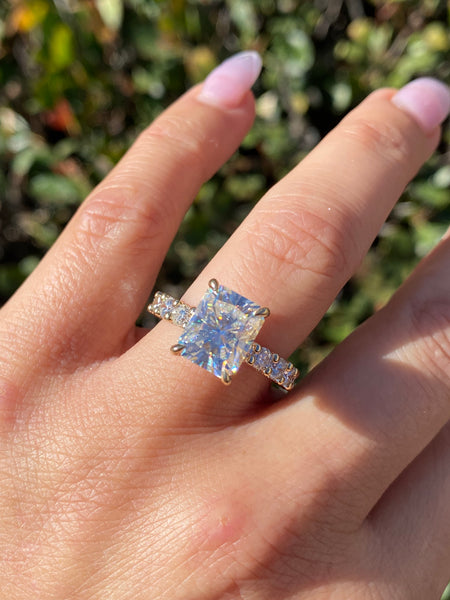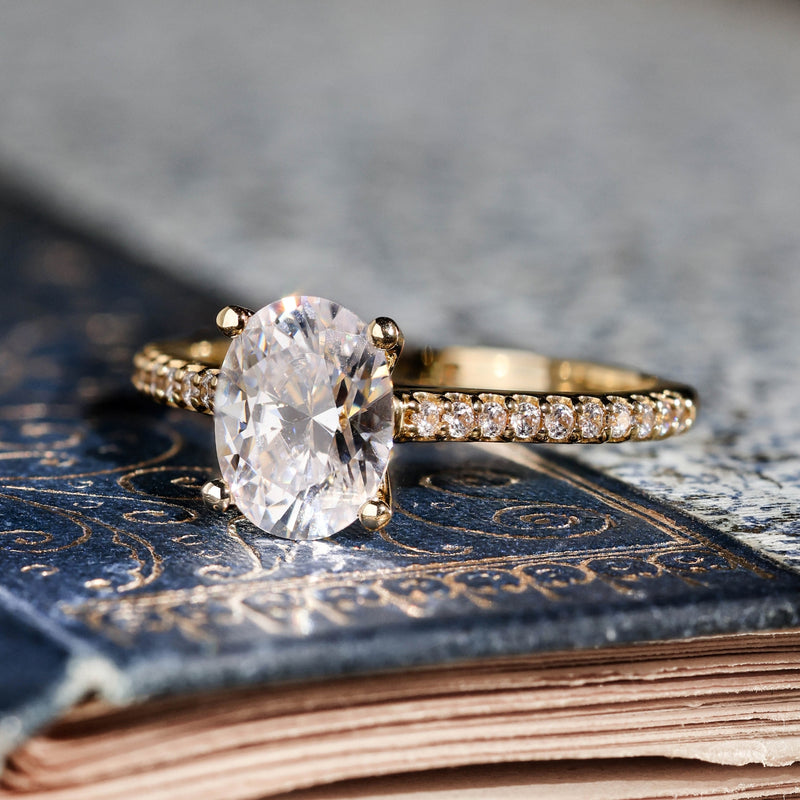The Advantages of Deciding On Laboratory Grown Diamond Interaction Rings for Your Proposal
Lab-grown Diamond engagement rings present an engaging alternative for pairs considering their proposition alternatives. These diamonds are fairly sourced and developed in controlled environments, addressing both ecological and moral issues. Additionally, they offer substantial price savings, allowing for larger stones or unique layouts. With innovations in modern technology, the allure of lab-grown rubies continues to expand. Understanding these advantages can affect a pair's decision-making process in extensive methods. What variables should be prioritized when making this choice?
Moral Sourcing and Environmental Effect
As customers increasingly prioritize sustainability, the increase of lab-grown Diamond interaction rings uses a compelling alternative to typically mined diamonds. These lab-created treasures are generated in controlled settings, significantly minimizing the ethical dilemmas related to Diamond mining. Traditional mining often entails unscrupulous labor practices and adds to environmental destruction, including deforestation and environment damage.

Cost-Effectiveness: More Value for Your Budget plan
Lab-grown Diamond engagement rings not only straighten with moral values however additionally offer significant cost advantages. Typically, these diamonds can be valued 20% to 40% lower than their extracted counterparts, enabling couples to optimize their spending plans without compromising top quality. This cost-effectiveness makes it possible for purchasers to buy bigger stones or higher-quality setups, improving the total visual of the ring.
Additionally, the openness in prices related to lab-grown diamonds removes the hidden expenses often related to mined rubies, such as certification and transportation fees. Pairs can likewise take advantage of lower insurance premiums because of the minimized worth of lab-grown diamonds.
Therefore, picking a lab-grown Diamond interaction ring ends up being an economically savvy decision, providing couples with even more value for their cash. This cost not only permits a greater selection yet additionally empowers couples to select a ring that genuinely mirrors their love and dedication.
Similar Physical and Chemical Characteristics
The attraction of lab-grown Diamond engagement rings lies not only in their ethical production however also in their amazing physical and chemical homes. These diamonds are created in regulated laboratory settings that mimic the all-natural problems under which rubies create in the Earth. As an outcome, lab-grown rubies have the very same crystal framework and solidity as their mined equivalents, score an ideal 10 on the Mohs range.
Both sorts of rubies consist of carbon atoms set up in a crystal latticework, making sure similar optical and physical attributes. Lab-grown diamonds show the very same luster, fire, and scintillation as all-natural diamonds, making them equivalent to the naked eye. Advanced gemological testing is needed to separate between both, highlighting their authenticity. This parity in homes allows customers to delight in the appeal and resilience of diamonds while making an environmentally aware choice.
Bigger Range of Choices
Laboratory grown Diamond interaction rings use a broader range of layout choices that deal with diverse preferences and choices. Their ability to be customized allows pairs to develop special items that reflect their individual design. This increased adaptability not only boosts the ring's emotional value however also makes it an extra personal choice.
Special Style Alternatives
While typical diamonds commonly feature restricted design choices, the surge of lab-grown Diamond interaction rings has opened up a more comprehensive spectrum of distinct styles and settings. This innovation allows pairs to explore more imaginative styles, ranging from vintage-inspired to modern-day geometric shapes. Lab-grown rubies can be crafted in various cuts, including oblong, pear, and heart shapes, supplying convenience that charms to diverse preferences. Additionally, the capability to combine these rubies with unusual band products, such as rose gold or ethically sourced steels, improves the overall visual. With distinctive setups like halo or bezel, these rings can be personalized to show private stories and preferences, making each interaction ring not just a sign of love, yet likewise a standout item of art.
Customization Possibilities
An expanding passion in lab-grown Diamond engagement rings has actually brought about an increase in personalization possibilities, allowing pairs to develop genuinely tailored pieces. Unlike traditional diamonds, lab-grown alternatives can be customized to fit private tastes and preferences. Pairs can select from a larger variety of sizes, colors, and forms, allowing them to select a diamond that resonates with their one-of-a-kind design. Furthermore, personalization extends past the Diamond itself; setups can be designed to enhance the chosen rock, whether one prefers classic, modern, or elaborate styles. This adaptability not only enhances the emotional significance of the ring but likewise permits for a more affordable technique, as couples can focus on features that matter most to them without endangering on top quality.
Transparency in the Diamond Industry
How can consumers browse the complexities of the Diamond industry when transparency remains an essential concern? The conventional Diamond market usually lacks clear details concerning the beginning and moral sourcing of rubies. This ambiguity can bring about customer mistrust and honest predicaments bordering problem rubies and ecological influence. Conversely, lab expanded rubies provide an option to this transparency problem. These rubies are created in regulated environments, allowing consumers to gain access to detailed details concerning their provenance.
Additionally, reputable sellers of laboratory grown diamonds generally give certificates that detail the information of the Diamond's production, including its size, high quality, and the technology made use of. This degree of openness empowers consumers to make enlightened options, aligning their purchases my website with individual worths. As understanding of dishonest methods in the Diamond industry expands, the clear, ethical nature of laboratory expanded diamonds placements them as an engaging choice for conscientious customers looking for engagement rings.
Sustaining Innovation and Technology
As the need for fairly sourced gems rises, supporting advancement and technology in the lab-grown Diamond sector comes to be crucial (lab grown diamond engagement rings). Lab-grown diamonds, developed via advanced techniques such as High Pressure Heat (HPHT) and Chemical Vapor Deposition (CVD), stand for a significant change in the Diamond industry. Purchasing these technologies not only enhances the quality and accessibility of rubies yet also reduces ecological effect contrasted to traditional mining techniques
Developments in production strategies have led to more efficient processes, resulting in reduced expenses for customers. This technological progression fosters competition, compelling typical Diamond producers to reconsider their techniques and embrace even more sustainable strategies. By supporting lab-grown rubies, customers contribute to a market that prioritizes ethical sourcing and technology, ultimately promoting an extra liable and environmentally conscious jewelry market. Accepting this brand-new age not only benefits consumers but also urges ongoing improvements in gems manufacturing modern technologies.

Customization and Modification Alternatives
Lab grown Diamond involvement rings provide a series of customization and personalization options that accommodate individual preferences. Customers can select unique design choices and customized rock characteristics, making certain that each ring reflects personal style and value. This capacity to tailor improves the psychological worth of the ring, making it a purposeful symbol of commitment.
Special Design Choices
What makes a ruby interaction ring absolutely special? Its special layout choices permit deep personalization, mirroring the couple's distinctive love tale. Laboratory produced diamonds use an array of options, from numerous cuts and setups to custom engravings. Pairs can pick from classic solitaires to intricate halo layouts, ensuring their ring aligns with personal tastes. In addition, the adaptability of laboratory expanded diamonds enables the consolidation of colored gemstones, such as sapphires or emerald greens, boosting originality. Modification encompasses the metal choice, whether it's white gold, yellow gold, or climbed gold. This flexibility in style not only creates an unique piece however likewise embodies the pair's commitment, making the engagement ring an unforgettable sign of their distinct trip with each other.
Tailored Rock Characteristics
When taking into consideration the qualities of a ruby involvement ring, couples discover that tailored rock alternatives substantially boost the customization procedure. Lab-grown diamonds supply a range of adjustable attributes, allowing couples to pick the size, form, and color that best shows their unique design and choices. This flexibility enables people to create a ring that signifies their love story. Furthermore, pairs can pick certain quality degrees and cut styles, ensuring that the Diamond not just meets their aesthetic desires yet also fits their spending plan. With lab-grown diamonds, the chance for personalization prolongs to establishing types and steel selections, additionally enhancing the ring's originality. Eventually, customized rock features empower pairs to develop a meaningful interaction ring that absolutely represents their relationship.
Often Asked Questions
Just How Do Lab Grown Diamonds Contrast to All-natural Diamonds in Regards To Durability?
Lab expanded diamonds and natural diamonds exhibit comparable sturdiness, as both are composed of carbon and share comparable hardness degrees. This makes them equally navigate to this website resistant to scraping and damages, making certain durability in any kind of precious jewelry setup.
Can Laboratory Grown Diamonds Be Resold or Assessed Like Natural Diamonds?
Laboratory grown rubies can undoubtedly be resold and assessed similarly to natural rubies. Their resale worth may differ due to market understandings and the growing accessibility of lab-created options in the jewelry industry.
What Is the Distinction in Glimmer In Between Laboratory Grown and Natural Diamonds?

Do Lab Grown Diamonds Come With Qualifications Like Natural Diamonds?
Laboratory grown rubies do include accreditations, similar to all-natural rubies. These certifications validate their top quality, consisting of elements like cut, shade, clearness, and carat weight, making certain consumers obtain a reliable evaluation of their Source acquisition.
Just How Are Lab Grown Diamonds Made to begin with?
Laboratory expanded diamonds are produced with 2 primary techniques: High Stress High Temperature (HPHT) resembles all-natural procedures, while Chemical Vapor Deposition (CVD) uses gases to deposit carbon, enabling regulated Diamond formation in a research laboratory environment. lab grown diamond engagement rings.
As customers increasingly focus on sustainability, the increase of lab-grown Diamond engagement rings offers an engaging alternative to commonly mined diamonds. Furthermore, the openness in pricing connected with lab-grown rubies removes the concealed prices usually connected with extracted diamonds, such as qualification and transport costs. Lab-grown rubies exhibit the very same luster, fire, and scintillation as all-natural rubies, making them identical to the nude eye. While conventional rubies usually come with restricted design choices, the surge of lab-grown Diamond engagement rings has opened up a wider range of one-of-a-kind styles and settings. Lab-grown diamonds, created via innovative techniques such as High Pressure High Temperature (HPHT) and Chemical Vapor Deposition (CVD), stand for a significant change in the Diamond sector.